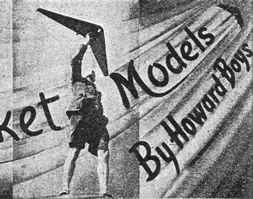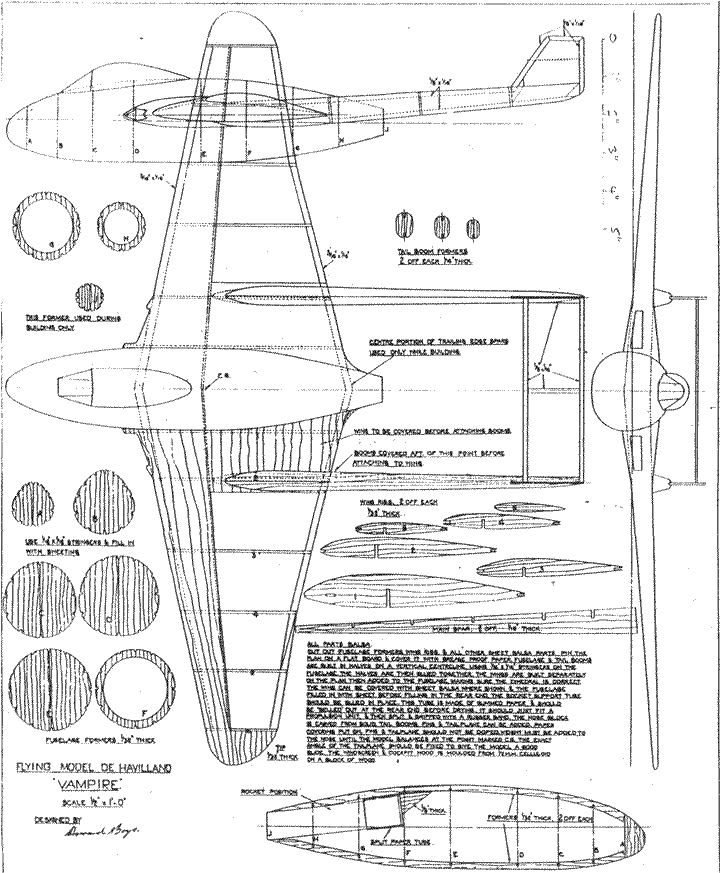|
|
|
|||
|
|
||||
|
|
||||
| PLAN - Rocket-powered Vampire | ||||
|
|
HOME | SITE MAP | FORUM | CONTACT |
|
||
|
ABOUT | MOTORS | MODELS | ARCHIVE | HISTORY | STORE | FAQ | LINKS
|
|
|
|
||||||||||||||
|
Rocket Models
by Howard Boys Reprinted from Aeromodeller, July 1947, pp. 466f. WITH every type of power unit there are advantages and disadvantages. With rockets the advantages seem to be absence of torque reaction, a large amount of thrust when required, and no winding up or prop swinging, or other manual effort, and the power unit does not suffer in crashes. Disadvantages are the heat of the efflux, and short duration of power. They are, however, great fun, and the model can always be flown as a glider without the rocket unit. |
|
||||||||||||||

The units for model propulsion have a fairly constant thrust for the whole time of burning, though some have a high initial burst for take-off We have two types of R.P. Unit, as they are called, available, the No. la and the No. 3. The No. la gives about ¾-oz. thrust for about five seconds. The No. 3 gives 3 ozs. thrust for 15 seconds, and has an extra burst for "take-off." The No. la R.P. Unit is suitable for models up to about 2 ft. wingspan, providing the weight is not more than about 1½ ozs., and the No. 3 R.P. Unit is suitable for models about ` Wakefield" size. Light models seem to give better results than hea7y ones. By way of interest the French rockets give about 7 ozs. thrust for 10 seconds, the size and weight being about the same as our No. 3 Units. We may of `course get more powerful units one day, but the thrust of the No. 3 Unit was made to suit my " Fire Engine " for the Handley Page competition in 1945, and the Home Office people approved of these for sale to the public but stated that if the thrust, or time of burning were increased, they were to be notified. There is a slight possibility that a rocket will explode, so the instructions say "retire immediately" for safety. I have known rare cases of early units exploding, but so far they have only blown out the front of the unit. If you come across a faulty unit, please send me details. While burning, the thrust usually increases slightly, but this is not shown up at all clearly in the flying. The original No. 1 Units caused the model to increase speed towards the end of the power flight, but this seemed as though it might be due to the total weight of the model decreasing. It did not show up until tested on a thrust recorder. It was then found to increase in thrust from ½ to 1 oz. thrust during the five seconds of burning. Fig. 1 shows thrust/time curves for the present units. It is not possible to get exactly the same thrust from two rockets, so a twin jet type would not be straight- forward. Fig. 2 shows a suggestion for balancing the thrust of two rockets against each other to operate a rudder. It would of course be necessary to experiment with the leverage and rudder area. The closer together the jets were, the less would be the trouble experienced. The type of model suitable for rocket drive is one with plenty of space behind the centre of gravity, so that the efflux can be directed away from the model. Tailless, twin boom, or pod and boom types are good, but it is also possible sometimes to fit a rocket in the tail end of a model. I have managed this very successfully in a scale model of the D.H. Swallow. The alteration in the position of the C.G. due to the burning of the charge only results in a higher gliding speed than with the C.G. further aft. To help overcome the difficulty of the charge being well behind the C.G. the unit can be directed downwards a little, so that the thrust helps to counteract the weight. The best position for the rocket unit is as close as possible to the C.G. so that there is no change of trim. This means using one of the previously mentioned types. Tails can be kept well out of the way, and quite safe while the model is in the air, but often suffer if the model comes to the ground with the unit burning, through bad launching, or other causes. It is possible to obtain asbestos paper that can be used to protect parts of the model. I have seen various types of models flying, and the most promising have always had the rocket mounted above the wing. These have all been boom types, sometimes single and sometimes twin, sometimes low, sometimes high. Tailplanes have been low or high. Bougeret put his rocket above the wing and his tail low down, and obtained very good flights. A friend of mine has had some very good flights with a model on the style of the American Yogi petrol model. This model has a tall narrow pod, with the boom low down. The wing is on top of the pod, the rocket on top of that, the tailplane low, and twin fins. One of the best ways of fixing the R.P. Units is in a split paper tube, with a rubber band round it to make the tube grip the unit. The tube is made by winding a strip of gummed paper round a unit, though not gummed to it. Remove the unit before the gum dries or the tube may shrink on. When dry, a narrow V is cut out so that with a unit in place and a rubber band round, the edges at the wide end of the V do not quite touch, The other end can be "belled" out to make it easier to insert the rocket. This end then faces aft in the model. The length of the tube can be from about one `and a half to three times the diameter of the rocket. The tube is glued in place in the model, and the rocket can be quite easily inserted and removed. If the tube is put inside the model it is best to block up the front end, and provide a good stop, so that if the model dives to the ground under power, the burning unit is not jerked into the model. Another method is to have a wire or balsa cradle on which the rocket is placed, and held with rubber bands. The best thing I have so far come across for lighting the touch paper, is an electric gas lighter. I bought an element that would screw into my pocket torch, and cut away one side so that the touch paper could be brought into contact with the red hot wire, and this did the trick, A lighted cigarette is also very good. Matches or petrol lighter can be used, but are not so good. Be warned! It is illegal to modify a firework, and at first the authorities were inclined to the view that it would constitute a modification to attach a firework to a model aeroplane! To use an ordinary sky rocket to drive a model aeroplane would definitely be illegal. |

-
Aeromodeller, July 1947 (p. 466)
|
||||||||||||||
Plan for Vampire
(A larger copy of the plan is also available to
view or download). |
|||||||||||||||
|
|
|
||||||||||||||
|
|
|
|
|
|
|
|
Acknowledgements - Article and plan contributed by Rocky Simmonds |
|
|
|
|
ABOUT | MOTORS | MODELS | ARCHIVE | HISTORY | STORE | FAQ | LINKS |
|
|
Terms of Use
|
Queries? Corrections? Additions?
Please
contact us.
|
|